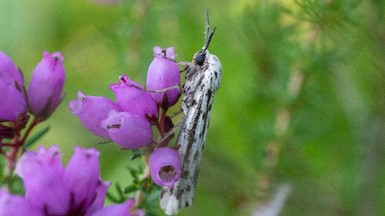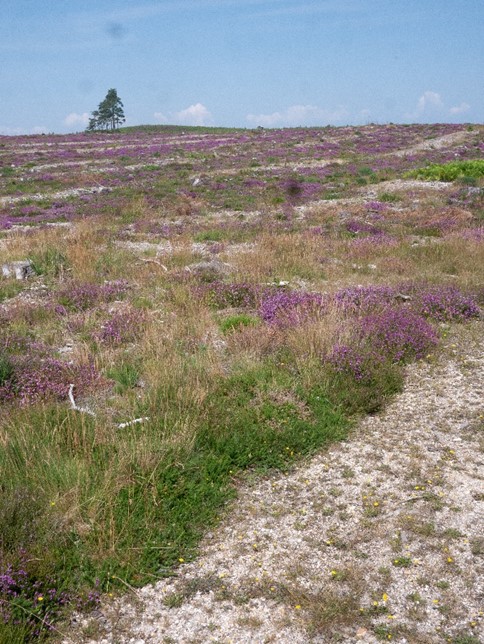Durwyn Liley, Footprint Ecology
Speckled Footman might seem a bit of a nerdy subject for this blog – but this enigmatic species has got me hooked.
The moth is Red Listed (critically endangered) and while it has probably always been rare, historically it was recorded from across Dorset and the New Forest. The Dorset Moths website included a summary of the species written by Peter Davey with an account by an entomologist from London who in 1890 was able to catch the train to Ringwood, walk out to St Leonards and ‘bag’ 18. It perhaps disappeared from the New Forest around the 1960s[1] but persisted on some of the Dorset Heaths. For example there were 20 records from Arne in the 1970s/early 1980s and over 120 were recorded from nearby Slepe Heath in 1976 (Pickess and Cadbury, 2008). This century there have been very few records. With friends and colleagues, I tried hard to find it in the Wareham Forest area in 2019, setting light traps across the Forest without success. Then in 2020, totally unexpectedly, I was amazed to find one in a moth trap – the first record of the native subspecies in Britain since 2014. Spurred on by that record, in 2021 we searched again more widely and were delighted to find 20!

Left: Speckled Footman © Durwyn Liley
So why is this particular species the subject of a blog when there are many very rare species that have very limited distributions and occur on the Dorset Heaths? The Speckled Footman is among the rarest – it is one of the most threatened of Britain’s moths.
It is a now entirely restricted (in the UK) to the Dorset Heaths, which have been under strict protection and conservation management since the 1980s; however, despite all that conservation effort, the moth is teetering on the edge of extinction – in fact it was feared extinct. Yet there is clearly hope and much to ponder.
We know little about the ecology of the Speckled Footman and therefore how to save it. The only records of larvae have been on Bristle Bent, a common and widespread grass common on the drier parts of Dorset Heaths. The grass does well along the edges of tracks and around bare ground, so there must be more subtle aspects to the species’ requirements. Many of the locations it has been recorded in are dry, open and catch the sun. However, the flurry of records in the 1970s from Slepe Heath were following the large fire on Hartland Moor. The recent records from Wareham follow the huge fire in 2020. Bristle Bent does flourish after a fire, so perhaps there is a link and a positive side to the devastating fire in Wareham Forest?
What are the future prospects for this species? There have been no records from the Slepe Heath area this century, and the moth is likely to have disappeared when the area was planted with conifers. Those conifers have long since been harvested and the heath is now part of the Purbeck Heaths NNR and is managed by the National Trust. The Purbeck heaths are now more joined up and managed as a landscape rather than compartmentalized sites. Clive Chatters (2021) in his recent book on heathlands in the UK refers to the Dorset Heaths as the heaths of hope due to these changes – it is nearly possible to walk from Studland to Bere Regis through a heathland landscape.

Perhaps this scale will work for Speckled Footman, but clearly lots of questions remain. Whether controlled targeted burns (part of routine heathland management) will be needed or whether the more extensive grazing systems that are being developed will create suitable conditions will be fascinating to see. Is there potential for the moth to spread back to old haunts, such as Slepe Heath and Arne?
The first Speckled Footman I saw was right at the end of lockdown and is for me a species of hope. It is iconic to the Dorset Heaths. With the Purbeck Heaths NNR, the Dorset Wildlife Trust’s work at Wild Woodbury and other changes, these are exiting times for the heathland landscape across Purbeck, with opportunities for wildlife and local people. I am hopeful that future includes Speckled Footman.
Right: Potentially suitable Speckled Footman habitat? Here at Arne following the removal of conifers from Hyde’s Heath © Durwyn Liley
References
Chatters, C., 2021. Heathland, British Wildlife Collection. Bloomsbury.
Pickess, B., Cadbury, J., 2008. Lepidoptera recorded at the RSPB’s Arne Nature Reserve, Wareham, Dorset 1970 – 95. RSPB.
